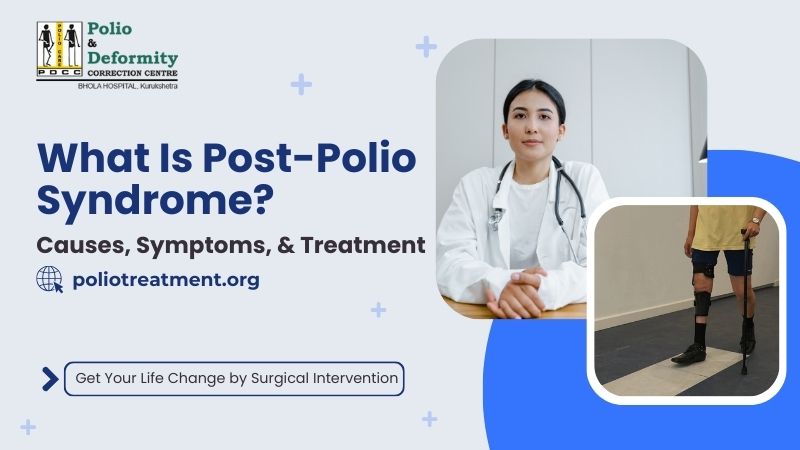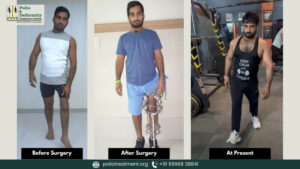Imagine defeating a disease as deadly as polio, only to find yourself struggling with new health issues decades later. Sounds unfair, right? But this is the harsh reality for many polio survivors in India and across the world. Post-polio syndrome (PPS) is a lesser-known yet serious condition that silently creeps in years after recovering from polio, bringing back muscle weakness, extreme fatigue, and pain.
With India officially declared polio-free in 2014, many believe polio is no longer a concern. However, for thousands of survivors who battled the virus in their childhood, the fight isn’t over yet. PPS can affect daily life, making even simple tasks exhausting. Unfortunately, due to low awareness, many mistake it for aging or general weakness, delaying proper treatment.
If you or someone you know had polio in the past, it’s crucial to understand what post-polio syndrome is, its warning signs, and how to manage it effectively. In this blog, we are going to discuss everything you need to know about PPS, its causes, symptoms, treatment options, and practical tips to lead a better life despite the challenges.
Keep reading—because awareness can change lives!
What is Post-Polio Syndrome?
Post-polio syndrome (PPS) is a health condition that develops in people who had polio earlier in life, causing new symptoms years after they have recovered. It is characterized by new muscle weakness, fatigue, and pain, even though the person had previously regained function.
Unlike polio, which is caused by the poliovirus, PPS is not an infectious disease. Instead, it results from the gradual deterioration of nerve cells that were previously damaged by polio. This condition primarily affects those who have severe polio infections, though mild cases can also develop PPS. Individuals who had polio as children may experience symptoms of PPS decades later, usually between 30 to 40 years after their recovery.
Since PPS is not contagious, it does not spread from person to person. However, it can significantly impact the daily life of polio survivors, affecting their mobility, strength, and independence.
Causes and Risk Factors of Post-Polio Syndrome
Main Cause: Nerve Deterioration Over Time
The primary cause of post-polio syndrome is the slow degeneration of motor neurons that were initially damaged by the poliovirus. During the recovery phase of polio, the body compensates by enlarging the remaining nerve cells. Over time, these overworked neurons become exhausted, leading to muscle weakness and other PPS symptoms.
Risk Factors for Developing PPS
Age and Duration Since Initial Polio Infection
PPS typically occurs 30 to 40 years after recovering from polio. Older individuals are more likely to experience worsening symptoms due to natural aging.
Severity of Original Polio Infection
Those who have a more severe polio infection, particularly with paralysis, have a higher risk of developing PPS.
Overuse of Muscles Over the Years
Excessive physical activity and strain on weakened muscles can accelerate the onset of PPS symptoms.
Understanding these risk factors can help polio survivors take preventive steps to manage their health effectively.
Signs and Symptoms of Post-Polio Syndrome
Physical Symptoms
Muscle Weakness and Atrophy: Gradual weakening of muscles, particularly in areas affected by the initial polio infection.
Fatigue and Exhaustion: Extreme tiredness that is not relieved by rest, affecting daily activities.
Joint Pain and Skeletal Deformities: Increased pain in joints and changes in posture due to muscle weakness.
Neurological Symptoms
Difficulty Swallowing (Dysphagia): Some individuals experience trouble swallowing food or liquids.
Breathing Problems: Weakness in respiratory muscles can lead to shortness of breath and lung infections.
Sleep Disorders (Such as Sleep Apnea): Many PPS patients suffer from sleep apnea, leading to disturbed sleep and fatigue.
Psychological Impact
Depression and Anxiety Due to Reduced Mobility: The loss of independence and physical abilities can lead to emotional distress and mental health issues.
Identifying these symptoms early can make it easier to manage the condition effectively.
Diagnosis of Post-Polio Syndrome
Clinical Evaluation by a Doctor
Doctors diagnose PPS based on medical history, symptoms, and a physical examination. Since there is no specific test for PPS, other conditions with similar symptoms need to be ruled out.
Important Diagnostic Tests
Electromyography (EMG): Measures electrical activity in muscles to detect nerve deterioration.
MRI and CT Scans: Used to examine the brain and spinal cord for abnormalities.
Muscle Biopsies: Helps identify muscle degeneration patterns
Excluding Other Conditions
Doctors must rule out conditions like arthritis, spinal cord disorders, and neuropathy before confirming PPS.
Treatment and Management of Post-Polio Syndrome
Medical Treatment has little role in the management of post-polio syndrome in the form of Nonsteroidal anti-inflammatory drugs (NSAIDs) and Physical Therapy and Rehabilitation.
Surgical intervention can help a Post-Polio Syndrome patient to change the quality of life.
Where To Find The Best Post-Polio Syndrome Treatment?
If you or your loved one is experiencing symptoms of Post-Polio Syndrome, getting expert medical care is crucial. At Bhola Hospital, Kurukshetra, Haryana, we specialize in the diagnosis, treatment, and management of musculoskeletal and gait-related problems caused by polio and other orthopedic conditions. Being the Best Polio Hospital In India, we will make sure to provide you with the best post-polio syndrome treatment at an affordable price.
Under the expert guidance of Dr. Suresh Bhola, a renowned Orthopedic Surgeon, we provide world-class treatment for:
Post-Polio Syndrome – Personalized rehabilitation and pain management strategies.
Deformity Correction – Using advanced Ilizarov techniques and hexapod (SUV) methods.
Musculoskeletal & Locomotor Deformities – Specialized care for polio, cerebral palsy, and post-traumatic limb deformities.
Fixator Assisted HTO – An innovative procedure for osteoarthritis of the knee.
With years of experience in treating both children and adults, Dr. Bhola is dedicated to improving mobility, reducing pain, and enhancing the quality of life for polio survivors.
After surgery life lifestyle modifications further help the patients, like –
Lifestyle Modifications
Energy Conservation Techniques: Avoiding overexertion and balancing rest with activity.
Regular but Moderate Exercise: Strengthening exercises without straining weak muscles.
Diet and Nutrition
Importance of a Balanced Diet for Muscle Health: A protein-rich and nutrient-dense diet helps maintain muscle function.
Mental Health Support
Counseling and Therapy for coping with PPS: Psychological support can help manage depression and anxiety.
After surgery, a combination of these strategies can significantly improve the well-being of PPS patients.
Why Choose Us?
Expert Care – Specialized treatment for orthopedic conditions
Advanced Techniques – Cutting-edge technology for deformity correction
Personalized Rehabilitation – Tailored therapy plans for every patient
Compassionate Approach – Focused on patient comfort and long-term well-being
Visit Us Today!
If you or a loved one needs expert care for Post-Polio Syndrome or any orthopedic condition, don’t wait. Schedule a consultation with Dr. Suresh Bhola and take the first step toward a healthier, more active life.
How to Prevent Post-Polio Syndrome?
Preventing Initial Polio Infection Through Vaccination
The polio vaccine is the most effective way to eliminate the risk of polio and PPS.
Healthy Lifestyle Choices to Slow Progression
Maintaining a balanced diet, regular exercise, and avoiding muscle overuse can delay symptoms.
Early surgical intervention
Early detection of symptoms and Early surgical intervention can help in better management of the condition.
Living with Post-Polio Syndrome: Tips and Advice
Managing Daily Activities Efficiently
Using adaptive equipment and pacing activities can help prevent fatigue.
Support Groups and Communities for PPS Patients
If you Join support groups, it will provide emotional support and shared experiences.
Role of Caregivers and Family Support
Encouraging a supportive environment can improve the mental and physical well-being of PPS patients.
Conclusion
Post-polio syndrome is a serious yet manageable condition that affects polio survivors years after recovery. While there is no conservative management for the condition, early diagnosis, Early surgical intervention, and lifestyle modifications can help manage symptoms effectively and qualitatively. Raising awareness about PPS is crucial to ensure that those affected receive the right care, treatment and support.
If you or someone you know is experiencing new symptoms after polio recovery, seeking medical advice at Bhola Hospital Kurukshetra, Haryana, is essential. With proper management, individuals with PPS can continue to lead fulfilling lives.
FAQs
Who is at risk of developing post-polio syndrome?
Polio survivors, especially those who had severe polio infections, are at higher risk of developing PPS.
What are the best ways to manage PPS symptoms?
Surgical intervention and lifestyle modifications help manage PPS symptoms.
How can one identify whether one is suffering from post-polio syndrome?
If you have any one of the following symptoms, you are likely suffering from post-polio syndrome.
Your condition is deteriorating day by day functionly
You fall frequently, or you have a fear of falling.
You are adding up obesity/gaining weight.
You are not exercising.
There is a recent injury to the lower limb.
There is a recent surgical intervention in the lower limb.
There is a fracture in the lower limb.
Initially, you used to walk for a longer period. But now you can not walk for that period.
Earlier, you did not need to keep your hand on the thigh, but now you have to keep your hand on the thigh while walking.
You get tired easily and the condition is progressively increasing.
Earlier you used to keep your whole foot on the ground while walking, but now, only the forefoot is kept on the ground, and the heel does not touch the ground.
If you have any one of the conditions mentioned above, get yourself checked at the Bhola Hospital, Kurukshetra. Before that, send your short video of walking in shorts (you can use a face cover also while making the video).
Can post-polio syndrome be cured?
Early diagnosis and proper management with Surgical intervention can improve the quality of life. At Bhola Hospital, Kurukshetra, Haryana, we offer personalized rehabilitation, pain management, and advanced orthopedic treatments to help patients maintain mobility and reduce discomfort.




